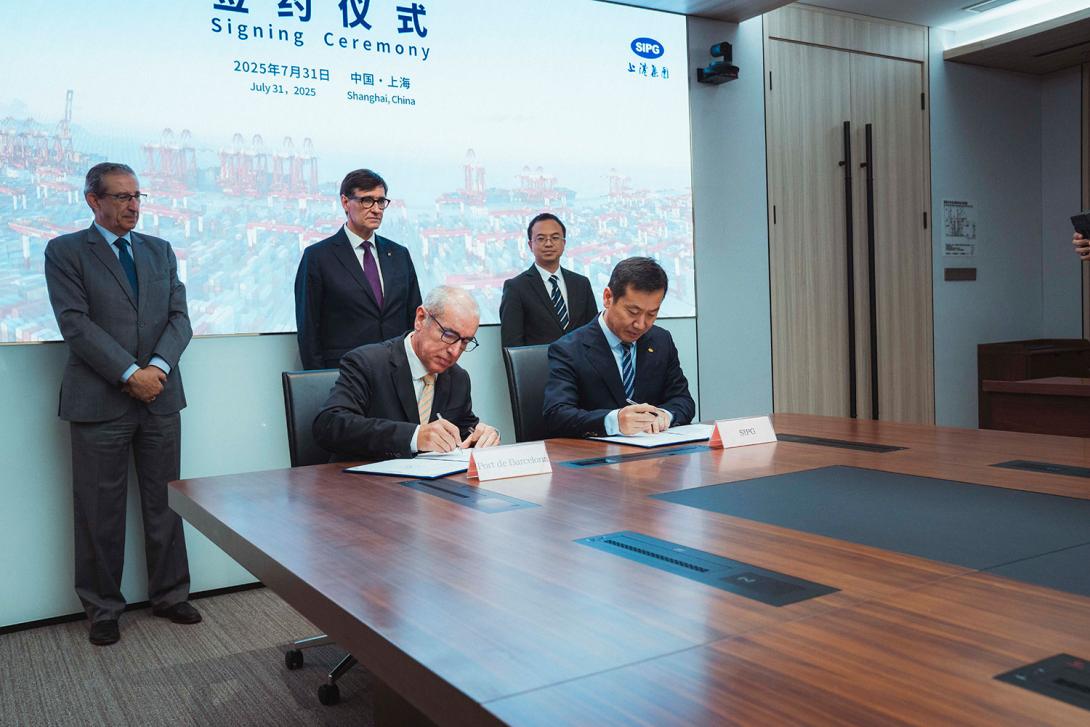The ports of Barcelona and Shanghai sign an agreement to strengthen their relationship and create a green corridor
The agreement was signed as part of the joint visit by the Port of Barcelona and the Generalitat de Catalunya to the Port of Shanghai.

The Port of Barcelona and Shanghai International Port Group (SIPG) have today signed an agreement to intensify the connections between both ports and share knowledge in the areas of digitalisation, standardisation and decarbonisation of maritime transport. The agreement was signed by the president of the Port of Barcelona, José Alberto Carbonell, and his counterpart from the SIPG, Song Xiaodong, as part of the joint visit by the Port of Barcelona and the Generalitat of Catalonia, represented by President Salvador Illa, to the Port of Shanghai.
The agreement seeks to consolidate the relationship between the Ports of Barcelona and that of Shanghai, the largest container port in the world and a pioneer in developing automation and respect for the environment. With this idea in mind, work is underway to foster port and maritime services between Barcelona and Shanghai and to develop smart and sustainable solutions in the areas of digitalisation and decarbonisation, sharing experiences and good practices and taking part in joint training programmes, and also in areas like management and security.
Signing this agreement marks another step in the relationship between both ports, which last year agreed to explore opportunities for collaboration in areas such as innovation and sustainability. One year on, this commitment has crystallised into an agreement that specifies the objectives and marks the way forward, with concrete initiatives to progress in addressing challenges such as decarbonising maritime transport.
Green Shipping and Digital Corridor
To this end, both ports have committed to developing a Green Shipping and Digital Corridor between the ports of Shanghai and Barcelona, which will cover maritime routes using ships powered by green energy, and developing the capacities and regulations to supply such fuels in both ports, offering emissions-neutral maritime services between the Far East and the Mediterranean.
The agreement also envisages collaboration in other specific areas in which Barcelona and Shanghai are already leading the way, such as cruises. Both ports will establish strategic collaboration in this area, coinciding with the reactivation of the Chinese market. Finally, they also agreed to set up a bilateral working group to define priorities and specific projects, developing specific agreements for each initiative.
Close business relationship
The signing of the agreement between the Port of Barcelona and Shanghai International Port Group is part of the close relationship that the Catalan port maintains with China, its main trading partner and the origin of practically 50% of the imports arriving here, which are mainly electronic products, machinery, textiles and consumer goods. Likewise, the ports of the Asian country are the destination of 10% of the exports passing through the Port of Barcelona, including agrifood products, wine, pharmaceutical products and automotive components.
Chinese companies also have a significant foothold at the Port of Barcelona, where Chinese shipping company COSCO made its first port call more than 50 years ago. However, the highest investment corresponds to Hutchison Port Holdings, the majority owner of BEST, one of the two large container terminals in the Port of Barcelona and the first semi-automatic one in Europe.
In recent years, Barcelona has further consolidated its role as the gateway for Chinese vehicles into Europe, becoming a hub for the distribution of brands from the Chery or SAIC groups, but also from other manufacturers such as Tesla or Cupra in the European market, largely thanks to its connectivity and advanced infrastructure.
After signing the agreement, the president of the Port of Barcelona and the deputy director general for Innovation and Business Strategy, Santiago Garcia-Milà, visited the facilities of the Yangshan Automated Container Terminal accompanied by managers of the Shanghai International Port Group.



